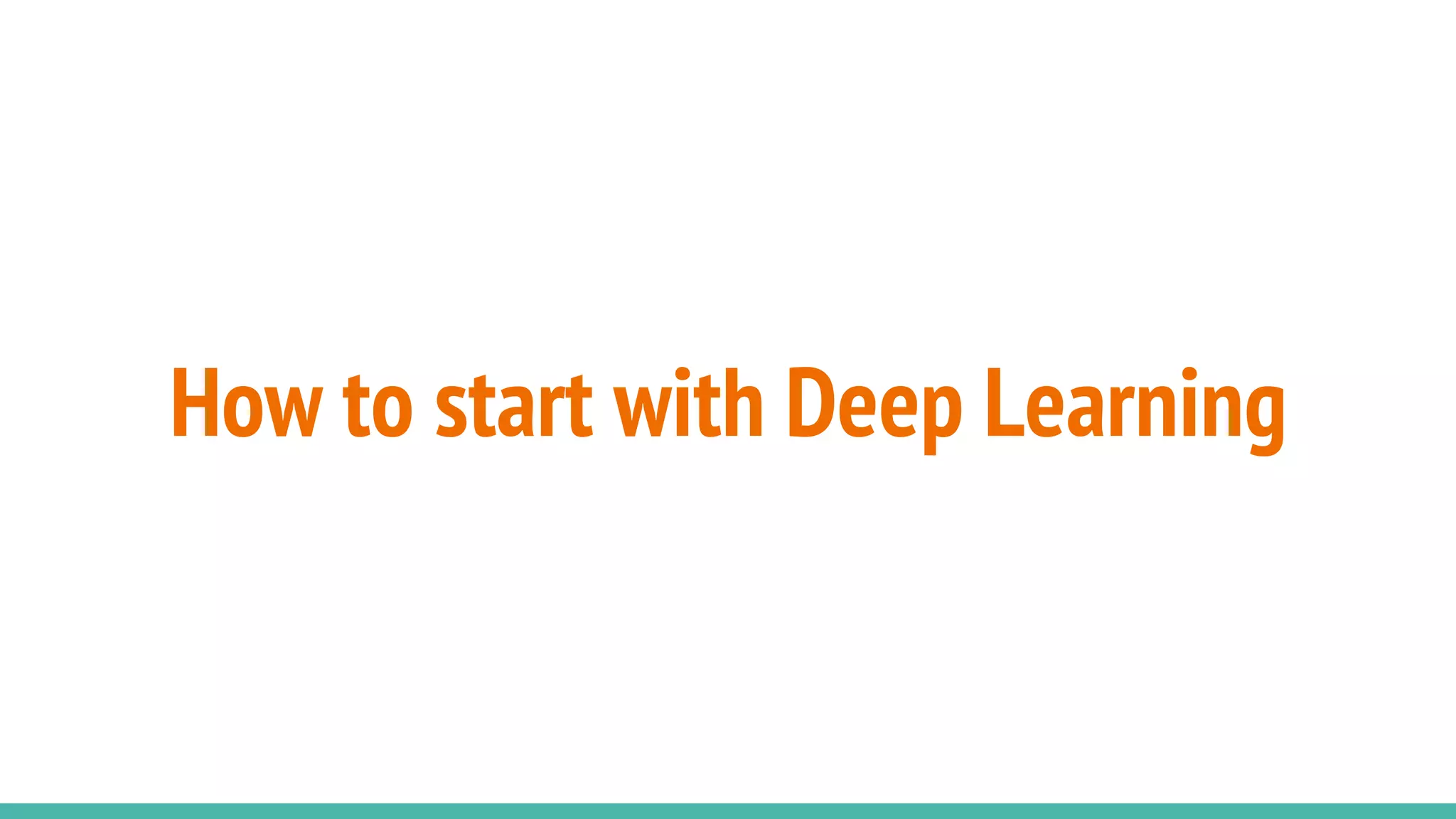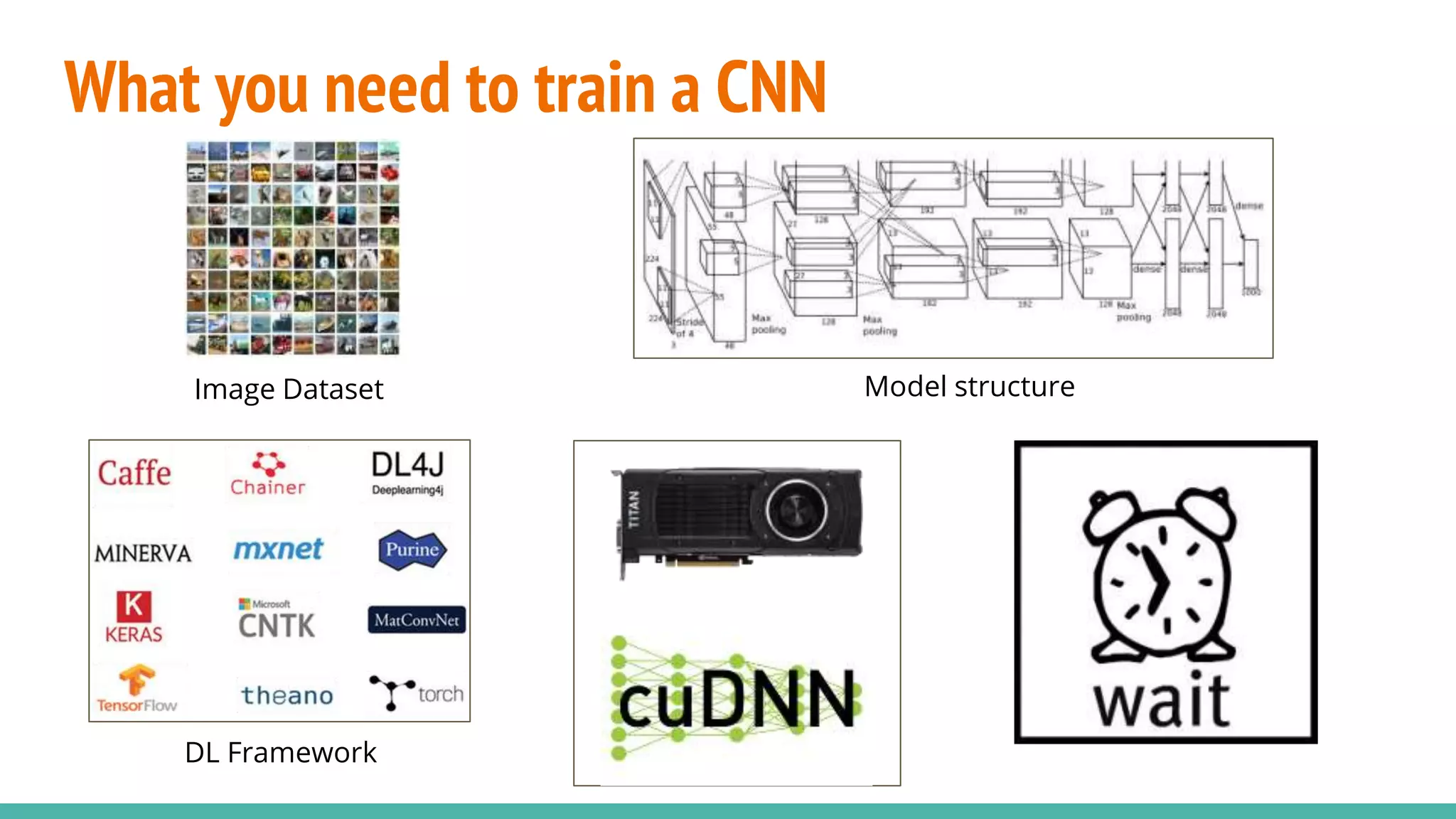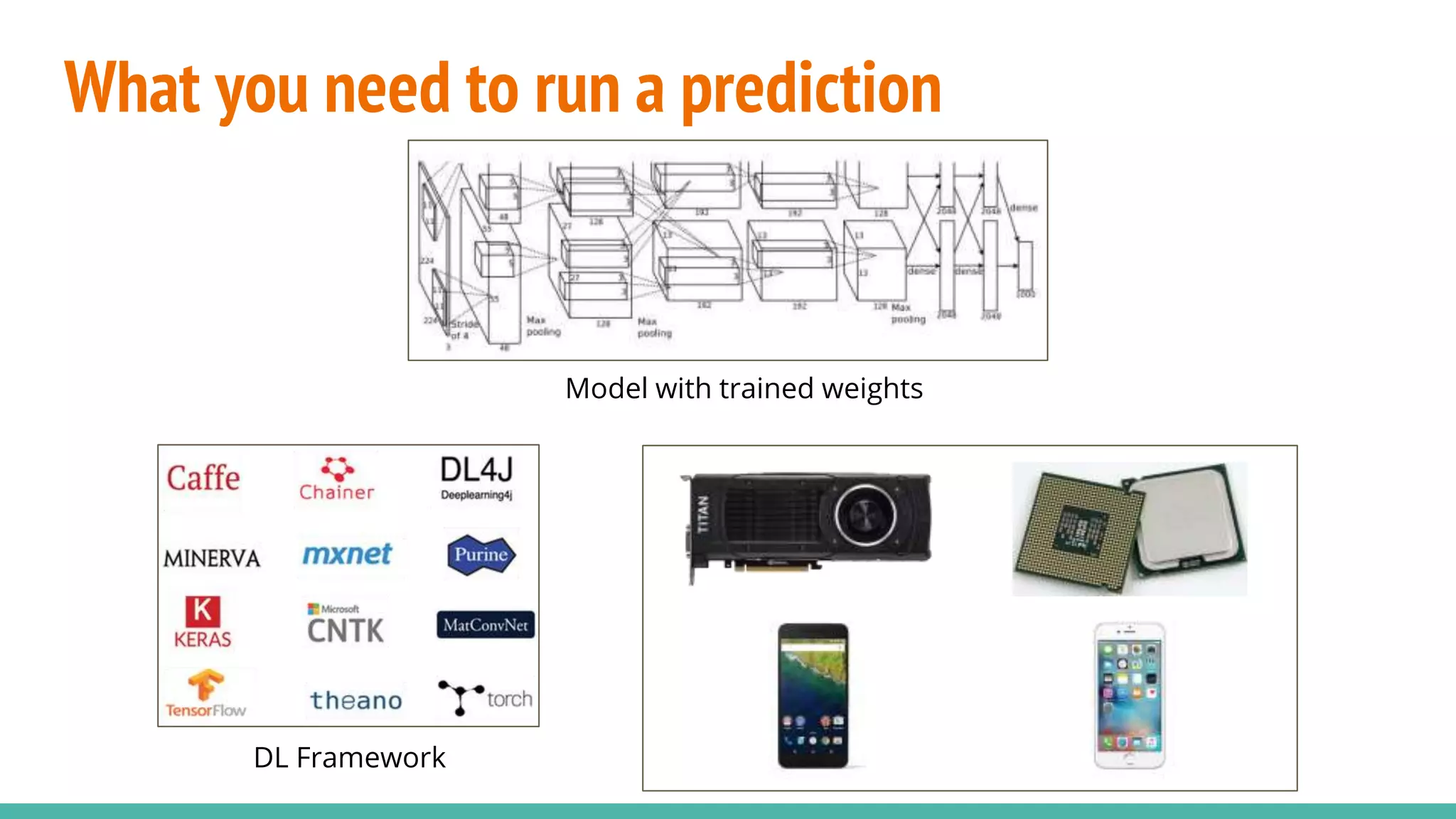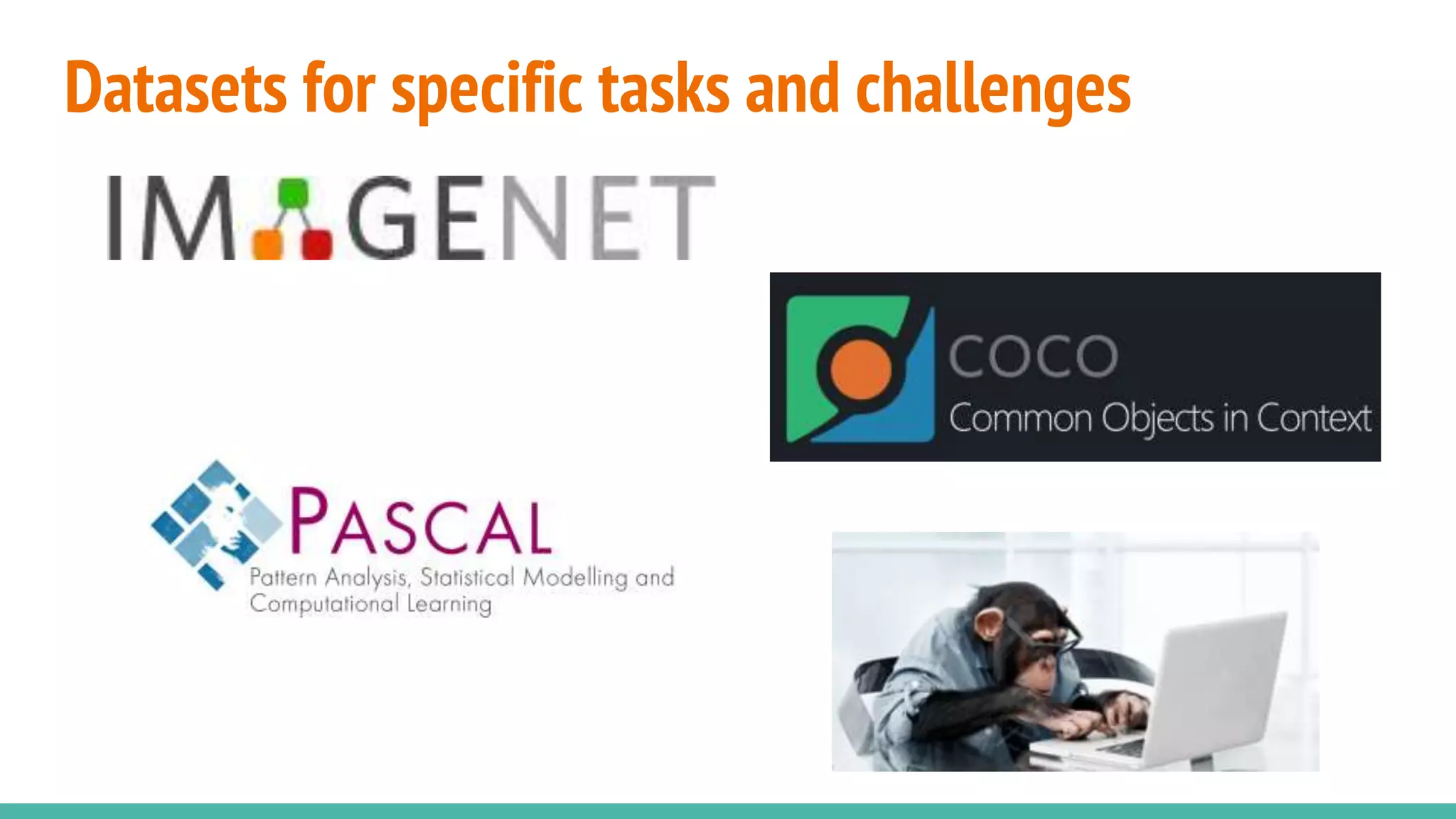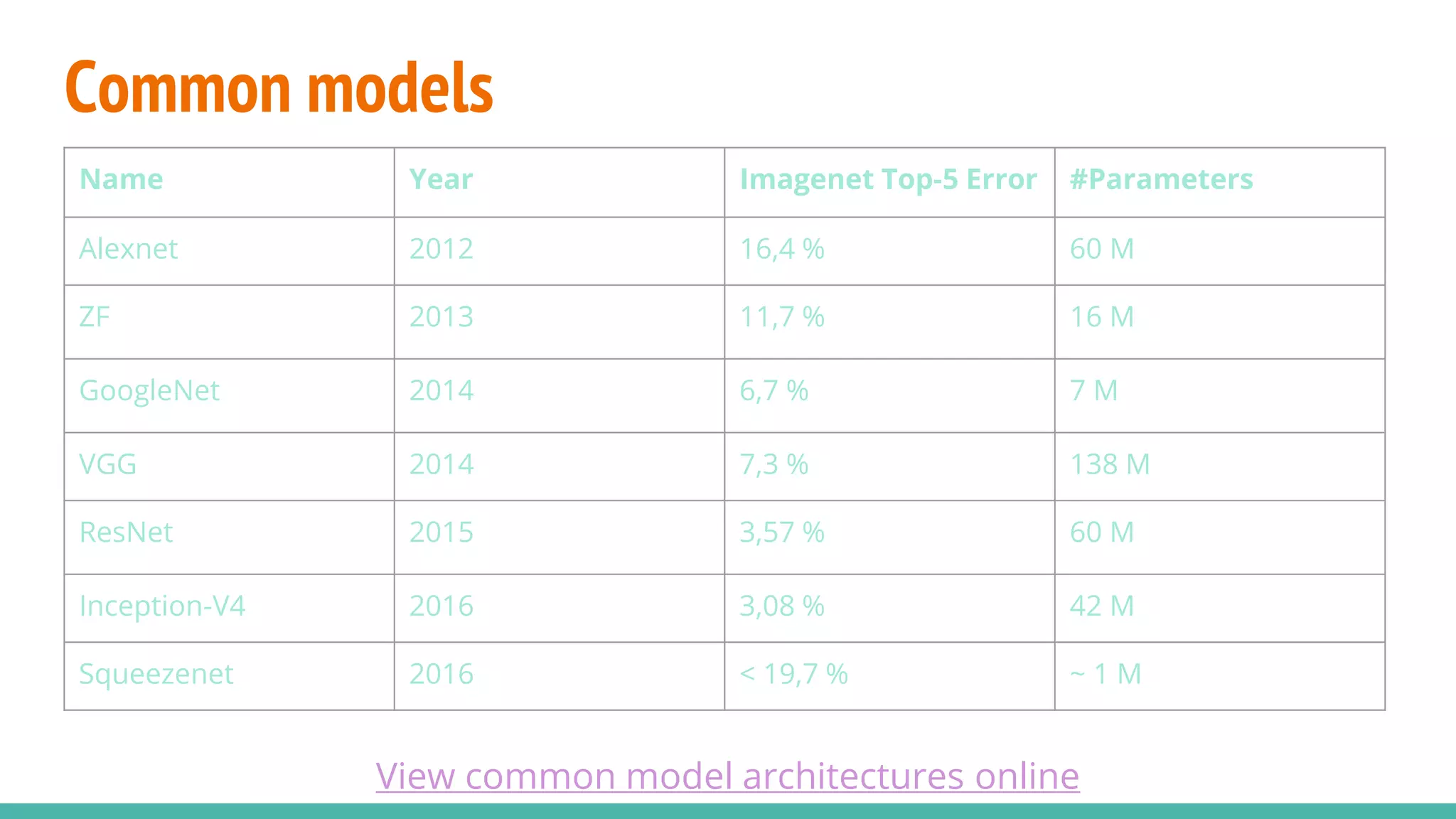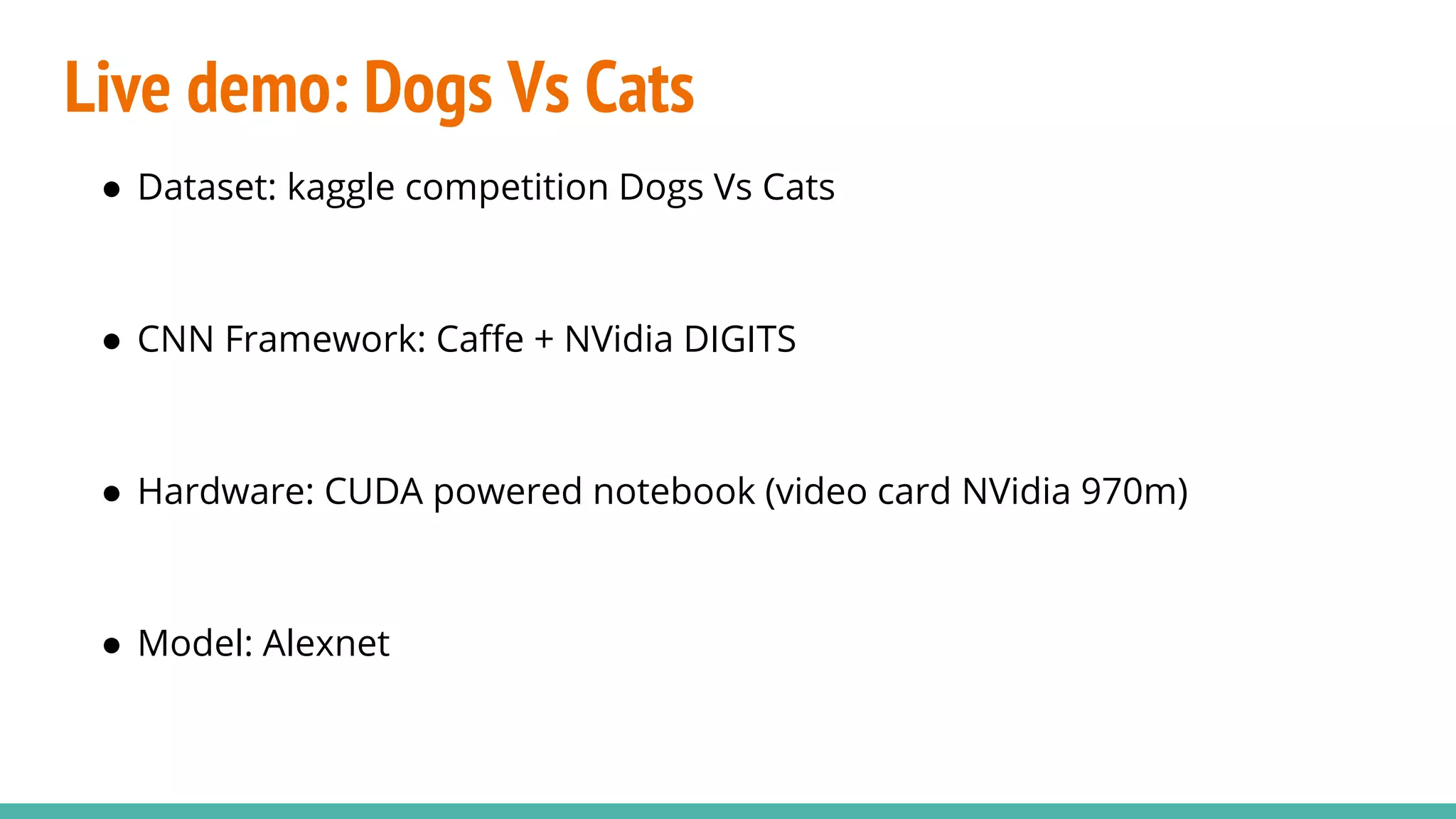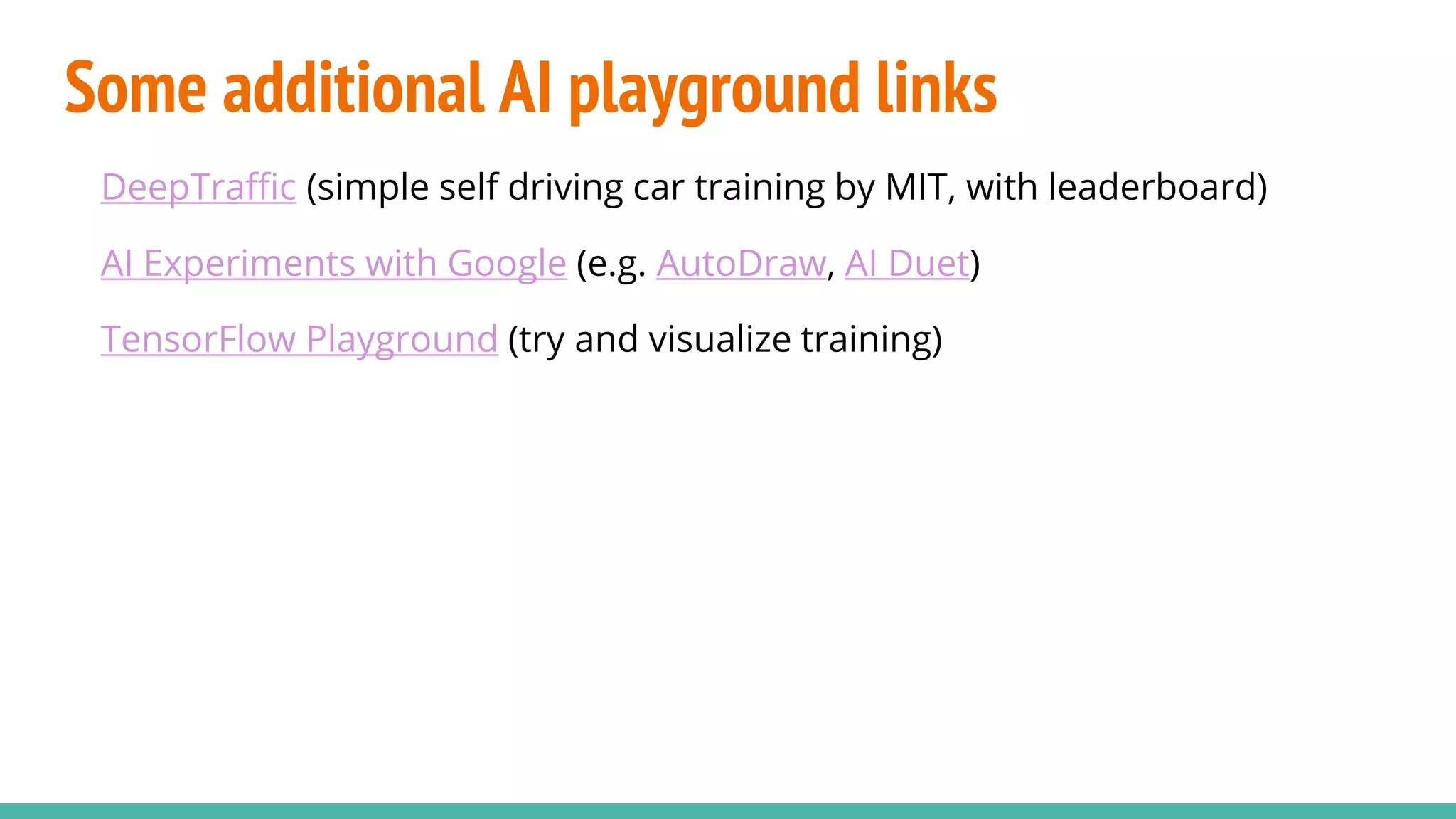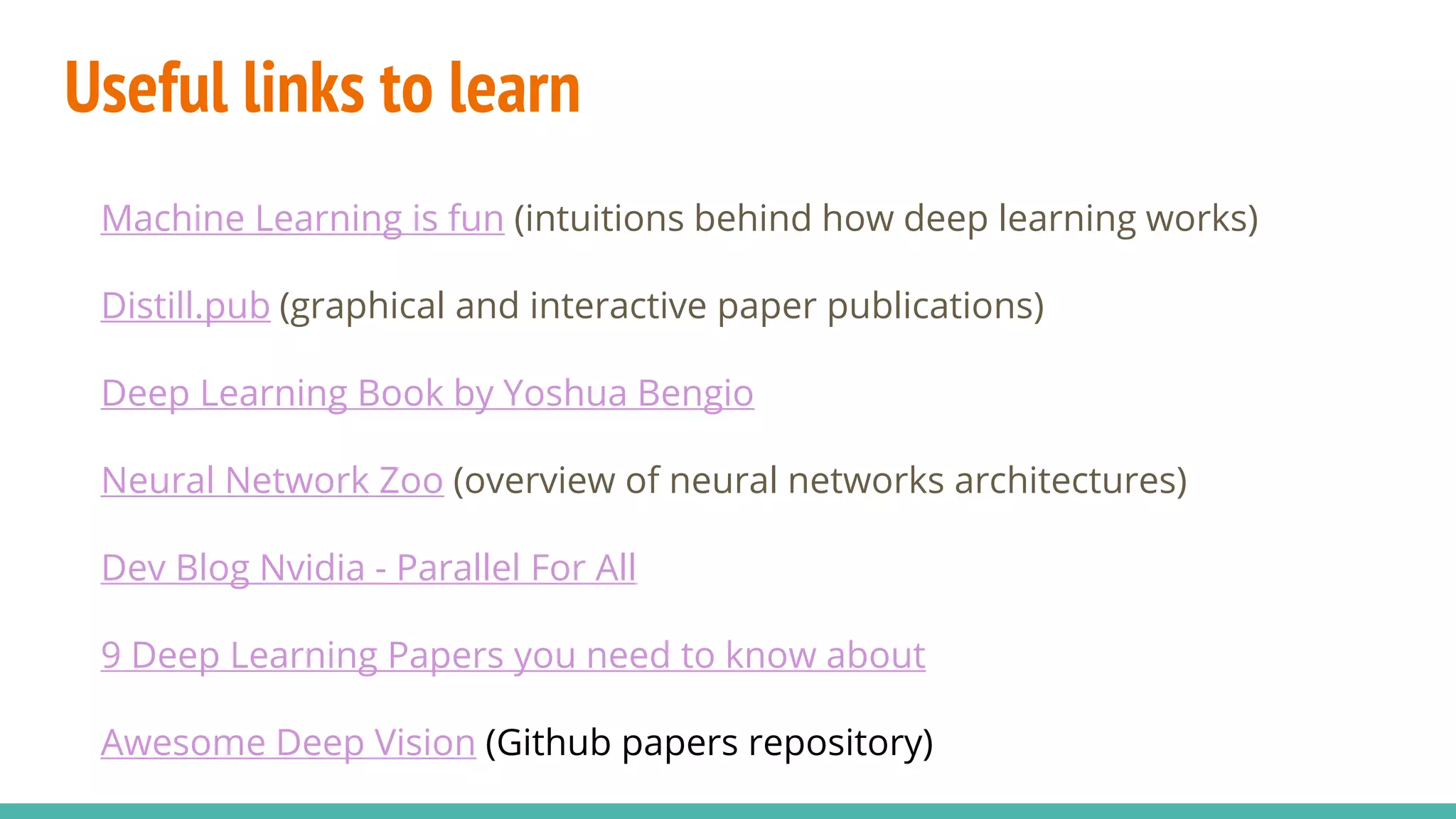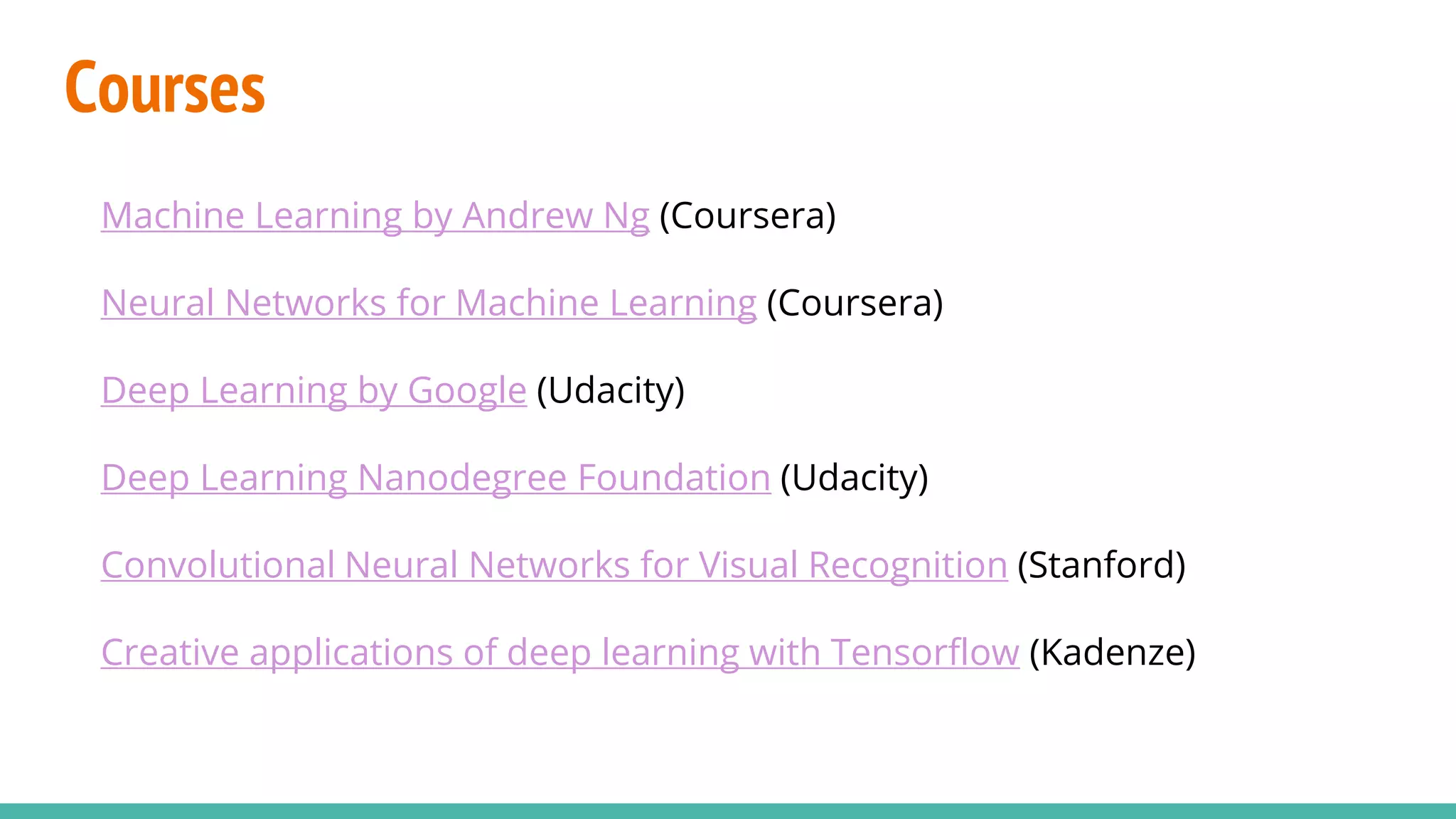The document provides an overview of deep learning, including its definition, types, applications, and fundamental concepts such as neural networks and various learning methods. It discusses the different types of learning, including supervised, reinforcement, and unsupervised learning, and highlights popular deep learning frameworks and model architectures. Additionally, it features a live demo on image classification and resources for further learning in the field of artificial intelligence and machine learning.
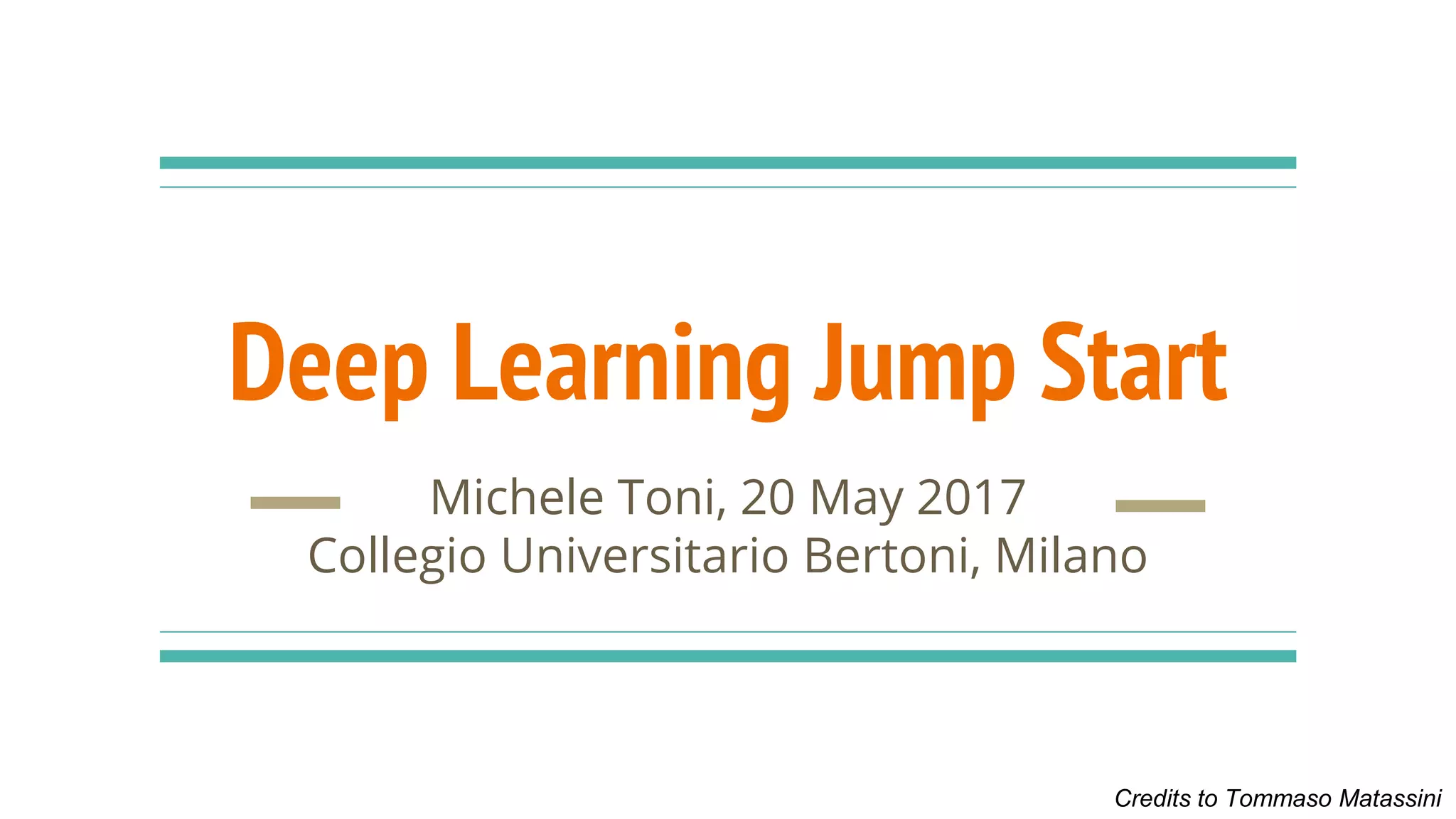
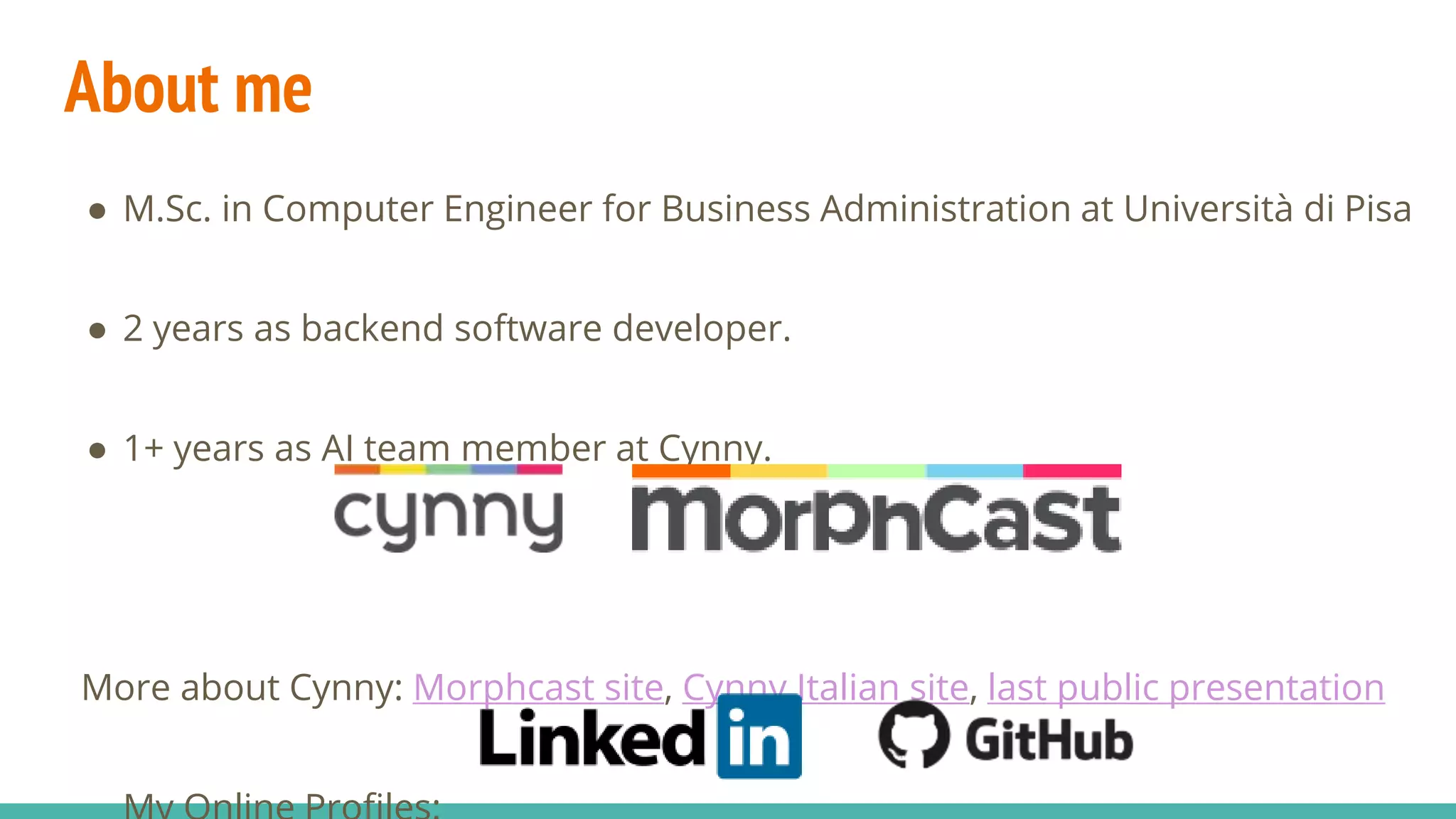
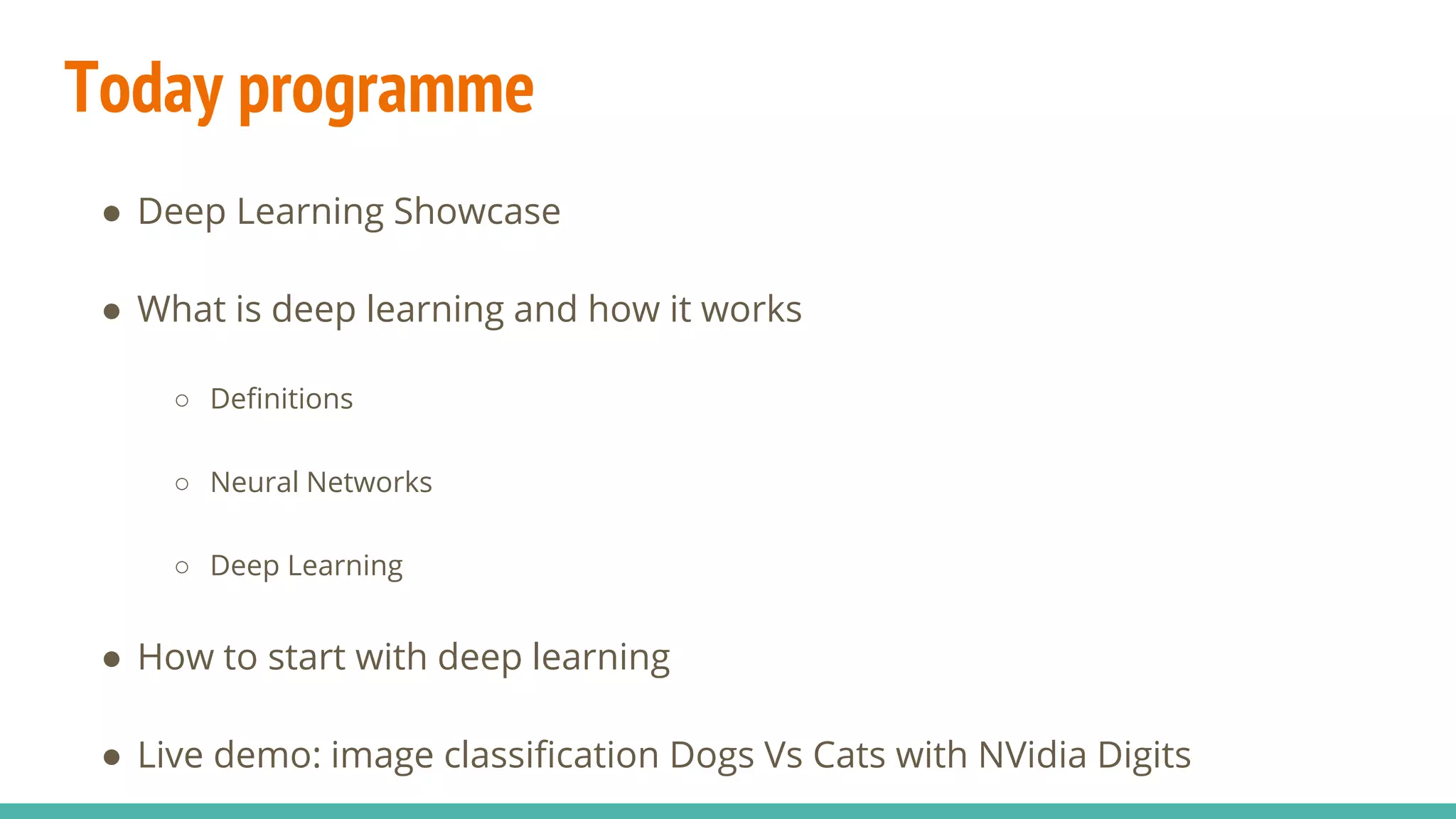
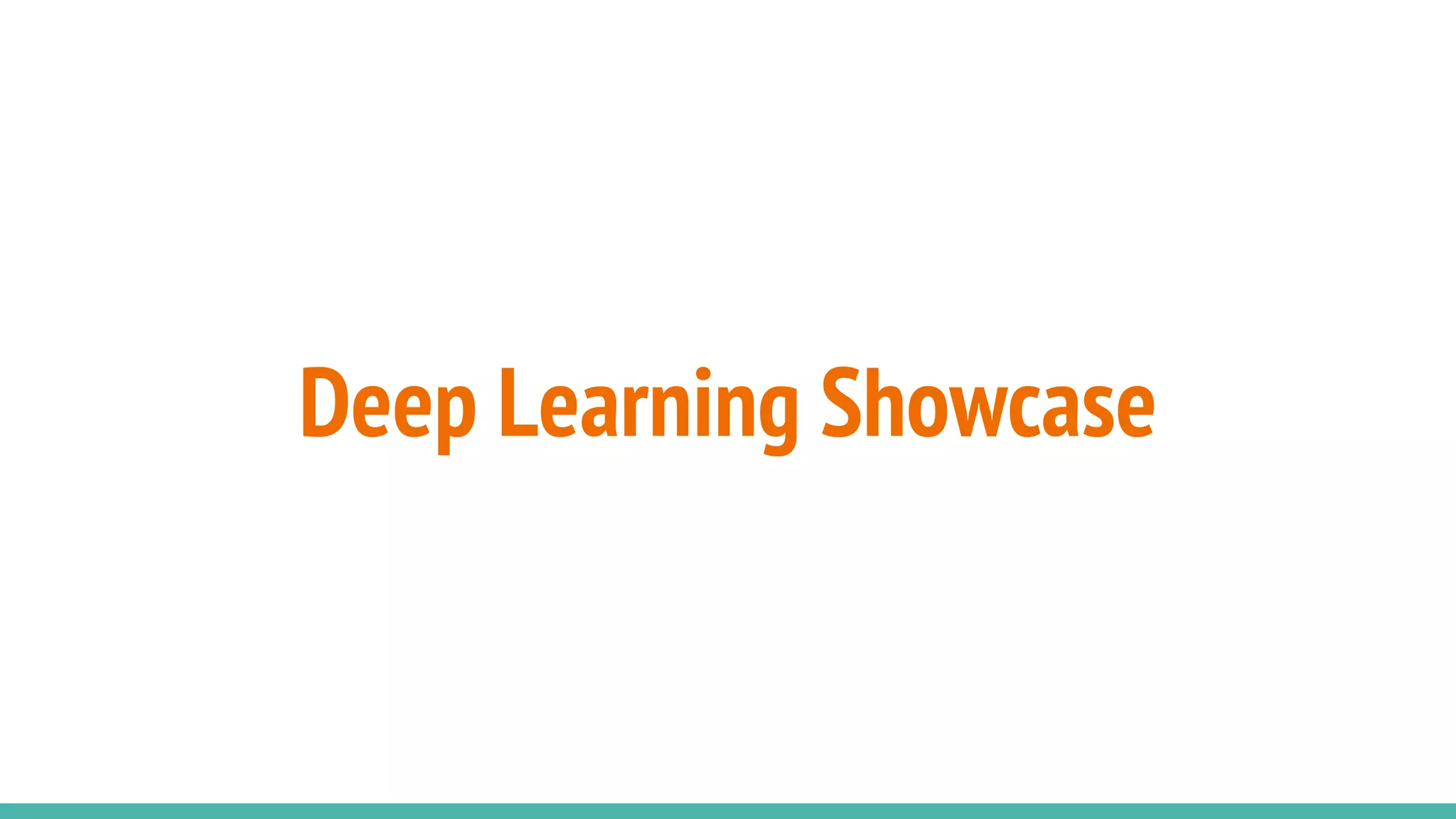
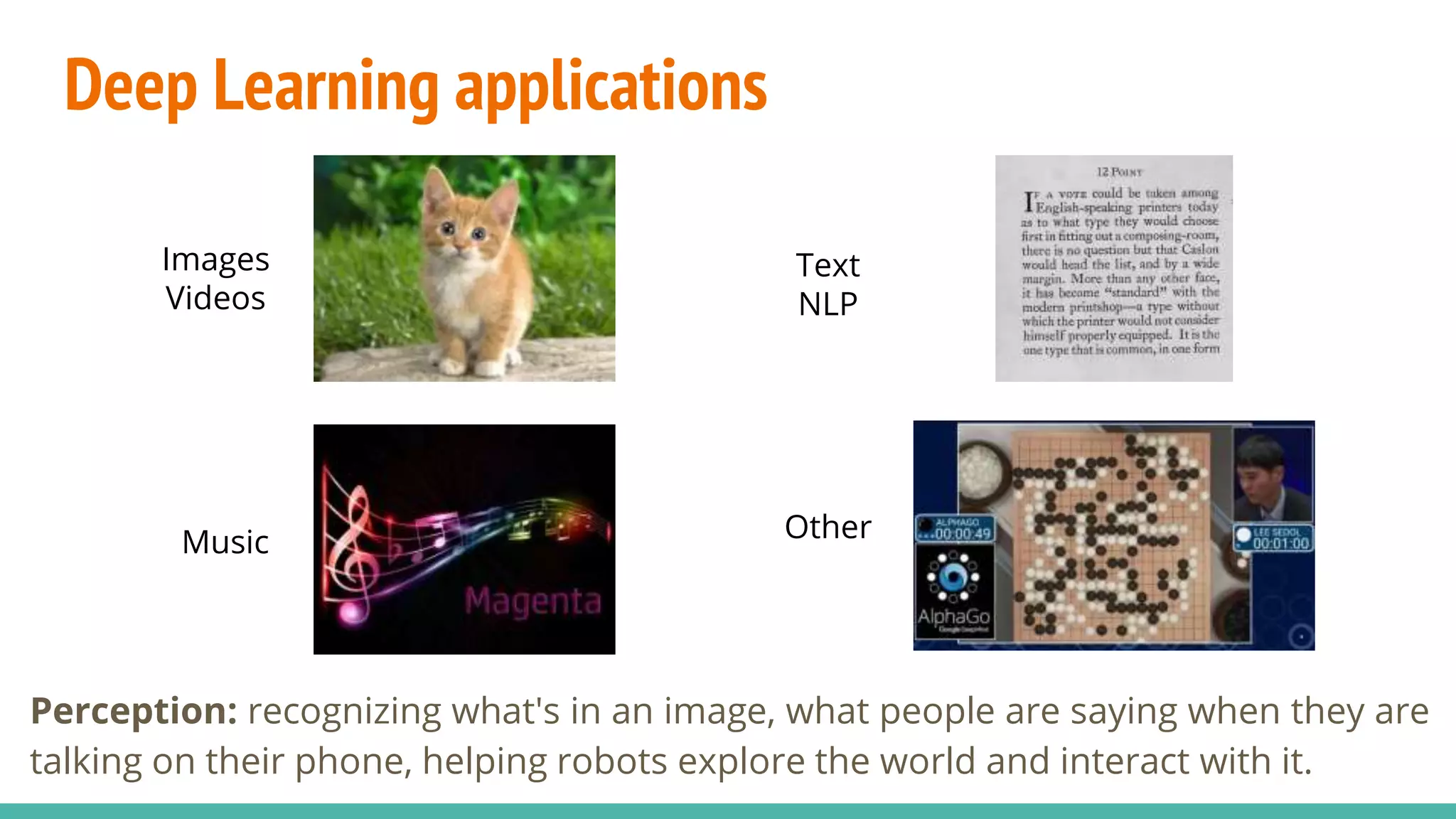
![Image Classification
[Try this online with CaffeJS]](https://image.slidesharecdn.com/17-05-20-bertoni-deeplearningjumpstart-170723160304/75/Deep-Learning-Jump-Start-6-2048.jpg)
![Object Detection - 1/2
[Source: Awesome Deep Vision]](https://image.slidesharecdn.com/17-05-20-bertoni-deeplearningjumpstart-170723160304/75/Deep-Learning-Jump-Start-7-2048.jpg)
![Object Detection - 2/2
[Source: DetectNet by Nvidia]](https://image.slidesharecdn.com/17-05-20-bertoni-deeplearningjumpstart-170723160304/75/Deep-Learning-Jump-Start-8-2048.jpg)
![Image Segmentation
[Source: SegNet Online Demo]](https://image.slidesharecdn.com/17-05-20-bertoni-deeplearningjumpstart-170723160304/75/Deep-Learning-Jump-Start-9-2048.jpg)
![Image Captioning
[Source: MS COCO Captioning Challenge 2015]](https://image.slidesharecdn.com/17-05-20-bertoni-deeplearningjumpstart-170723160304/75/Deep-Learning-Jump-Start-10-2048.jpg)
![Image Captioning - Facebook easy approach
[Source: The Verge article]](https://image.slidesharecdn.com/17-05-20-bertoni-deeplearningjumpstart-170723160304/75/Deep-Learning-Jump-Start-11-2048.jpg)
![Neural Art - DeepDream 1/3
[Source: Google Inceptionism]](https://image.slidesharecdn.com/17-05-20-bertoni-deeplearningjumpstart-170723160304/75/Deep-Learning-Jump-Start-12-2048.jpg)
![Neural Art - DeepDream 2/3
[Source: L’Altra Toscana: Garfagnana]](https://image.slidesharecdn.com/17-05-20-bertoni-deeplearningjumpstart-170723160304/75/Deep-Learning-Jump-Start-13-2048.jpg)
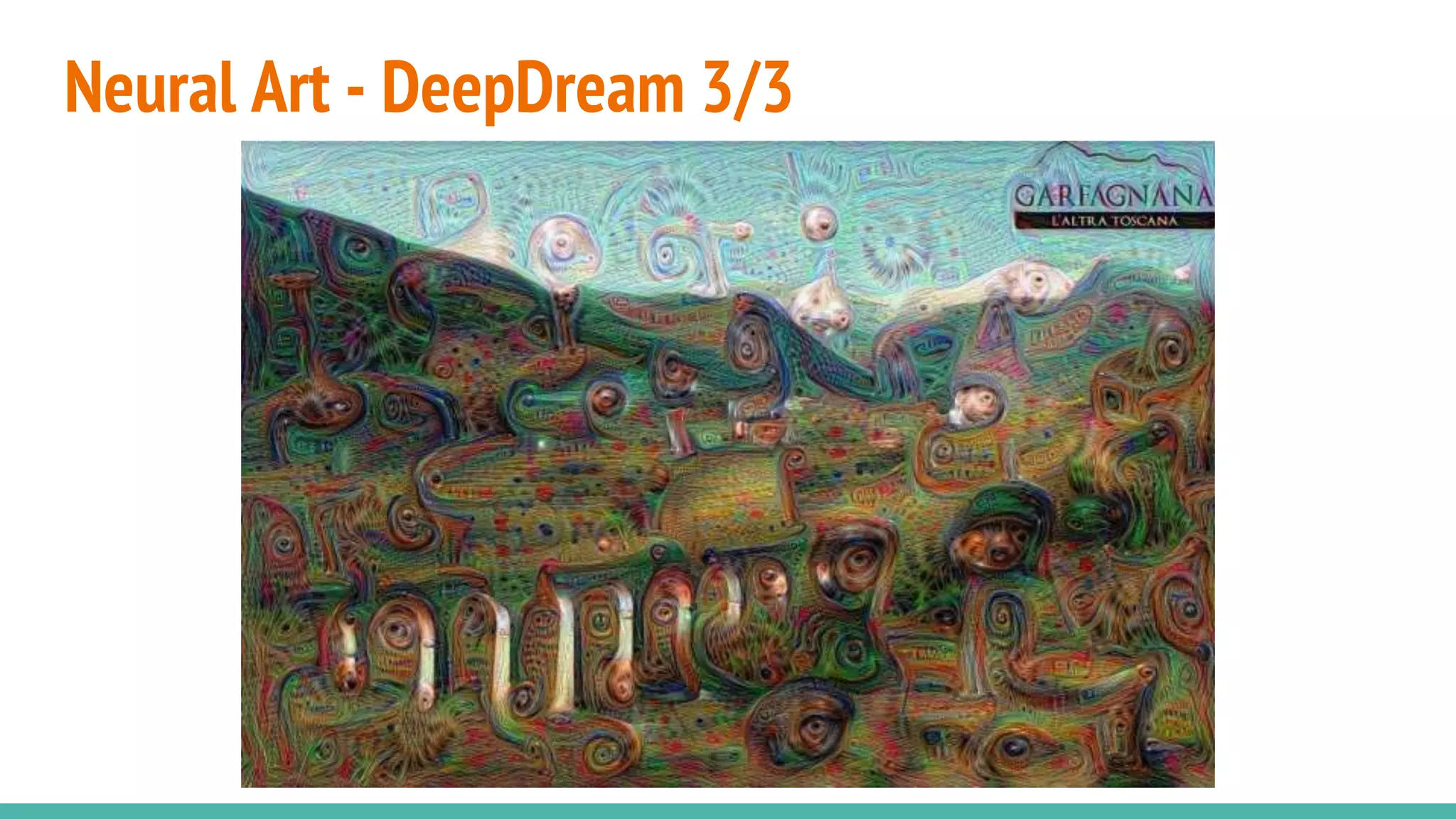
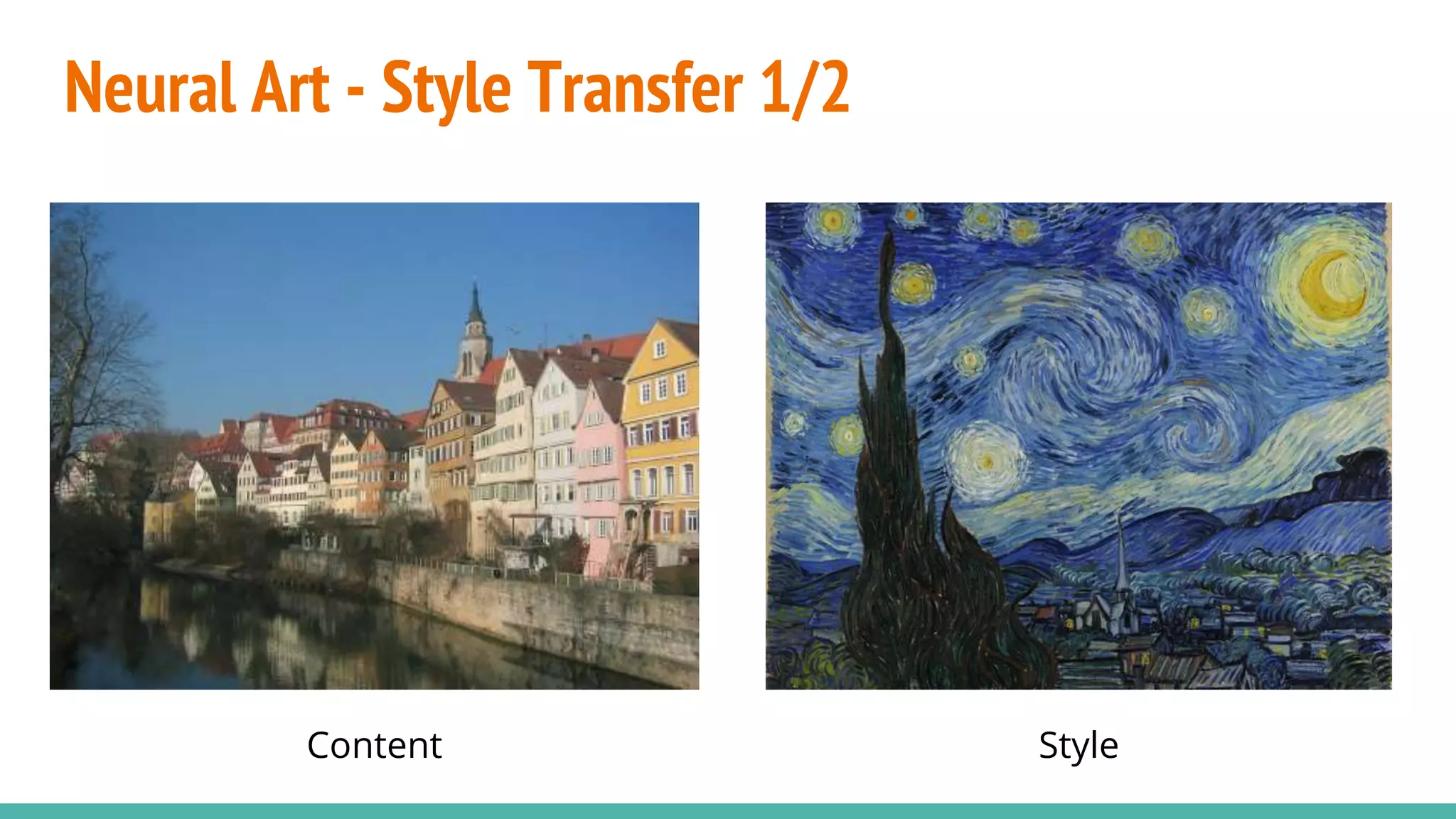
![Neural Art - Style Transfer 2/2
[Try this: DeepDream, Prisma, Vinci]](https://image.slidesharecdn.com/17-05-20-bertoni-deeplearningjumpstart-170723160304/75/Deep-Learning-Jump-Start-16-2048.jpg)
![Neural Art - Deep Photo Style Transfer
[Source Code and details: DeepPhoto Github]](https://image.slidesharecdn.com/17-05-20-bertoni-deeplearningjumpstart-170723160304/75/Deep-Learning-Jump-Start-17-2048.jpg)
![Text Generation - Hemingway style
[Source: Hemingway style and Super Mario level generation]](https://image.slidesharecdn.com/17-05-20-bertoni-deeplearningjumpstart-170723160304/75/Deep-Learning-Jump-Start-18-2048.jpg)
![Sequence2Sequence - Language translation
[Source: Attention and Memory in Deep Learning and NLP]](https://image.slidesharecdn.com/17-05-20-bertoni-deeplearningjumpstart-170723160304/75/Deep-Learning-Jump-Start-19-2048.jpg)
![Sequence2Sequence - Chat bot
[Source: ChatBots with seq2seq, seq2seq Github]](https://image.slidesharecdn.com/17-05-20-bertoni-deeplearningjumpstart-170723160304/75/Deep-Learning-Jump-Start-20-2048.jpg)
![Music Generation - Google Magenta and others
[Google Magenta Song, Fake Beatles Song, DeepBach by Sony CSL Music]](https://image.slidesharecdn.com/17-05-20-bertoni-deeplearningjumpstart-170723160304/75/Deep-Learning-Jump-Start-21-2048.jpg)
![Generative Adversarial Network - pix2pix
[Try this: pix2pix Demo]](https://image.slidesharecdn.com/17-05-20-bertoni-deeplearningjumpstart-170723160304/75/Deep-Learning-Jump-Start-22-2048.jpg)
![Generative Adversarial Network - CycleGAN
[Source code and details: CycleGAN Github]](https://image.slidesharecdn.com/17-05-20-bertoni-deeplearningjumpstart-170723160304/75/Deep-Learning-Jump-Start-23-2048.jpg)
![Reinforcement learning - Atari Breakout
[Atari Breakout Video, Flappy Bird, OpenAI Gym]](https://image.slidesharecdn.com/17-05-20-bertoni-deeplearningjumpstart-170723160304/75/Deep-Learning-Jump-Start-24-2048.jpg)
![Image analysis (old) approach: Computer Vision
HOG Face detector
[Source: dlib site]
Local Binary Pattern
[Source]](https://image.slidesharecdn.com/17-05-20-bertoni-deeplearningjumpstart-170723160304/75/Deep-Learning-Jump-Start-25-2048.jpg)
![Why we use Deep Learning
[Source: Nervana Systems]](https://image.slidesharecdn.com/17-05-20-bertoni-deeplearningjumpstart-170723160304/75/Deep-Learning-Jump-Start-26-2048.jpg)
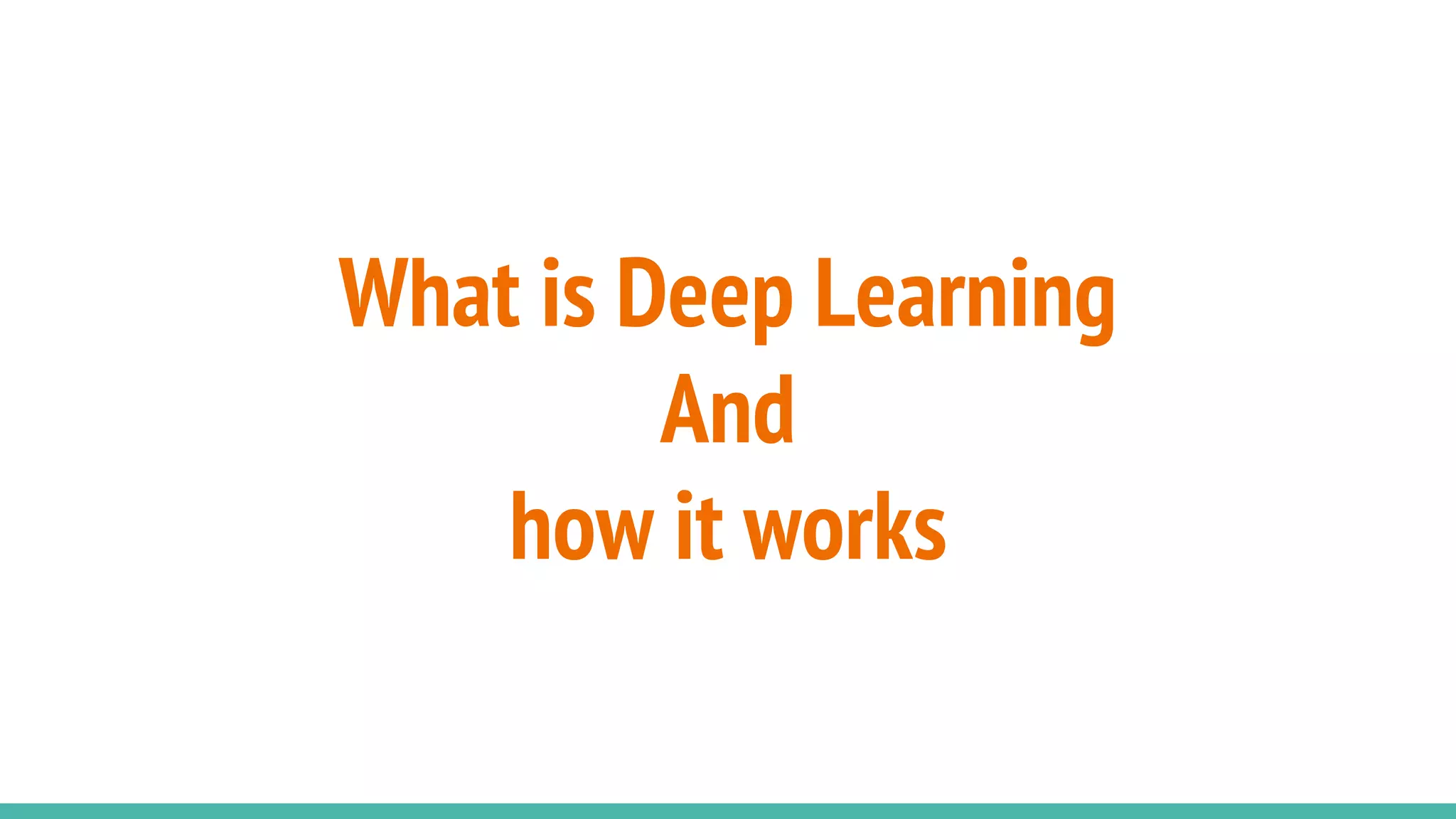
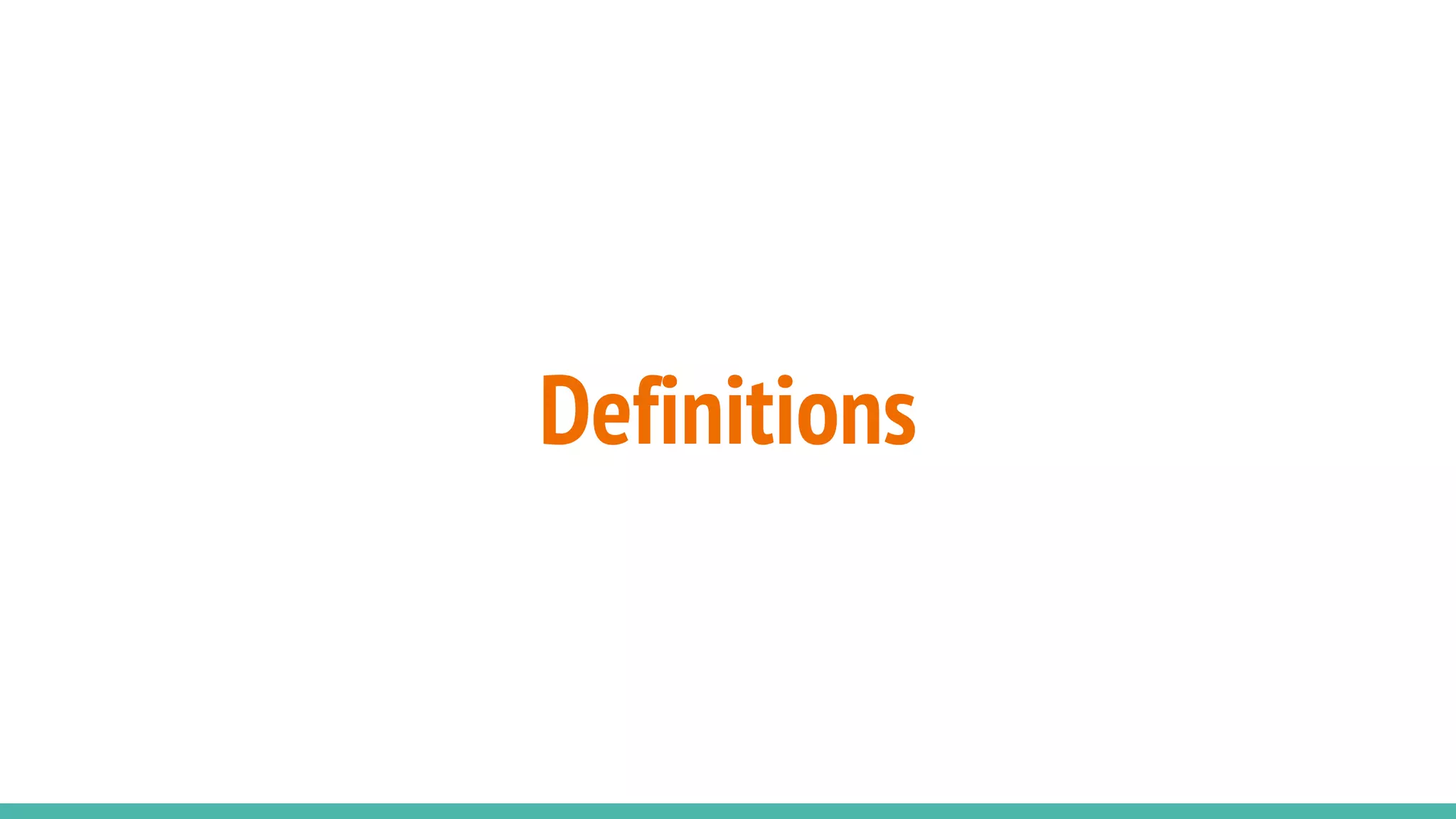
![AI Vs Machine Learning Vs Deep Learning
[Source: NVidia Blog]](https://image.slidesharecdn.com/17-05-20-bertoni-deeplearningjumpstart-170723160304/75/Deep-Learning-Jump-Start-29-2048.jpg)
![Artificial Intelligence definition
Artificial intelligence (AI) is an area of computer science that emphasizes the
creation of intelligent machines that work and react like humans.
Some of the activities computers with artificial intelligence are designed for
include:
● Speech recognition
● Learning
● Planning
● Problem solving
[Source: Techopedia]](https://image.slidesharecdn.com/17-05-20-bertoni-deeplearningjumpstart-170723160304/75/Deep-Learning-Jump-Start-30-2048.jpg)
![Machine Learning definition
Machine learning according to Arthur Samuel in 1959, gives "computers the
ability to learn without being explicitly programmed."
It explores the study and construction of algorithms that can learn from and
make predictions on data – such algorithms overcome following strictly
static program instructions by making data-driven predictions or decisions,
through building a model from sample inputs.
[Source: Wikipedia]](https://image.slidesharecdn.com/17-05-20-bertoni-deeplearningjumpstart-170723160304/75/Deep-Learning-Jump-Start-31-2048.jpg)
![Types of learning
● Supervised learning: learn to predict an output when given an input
vector. We know the correct matching between input and output.
● Reinforcement learning: learn to select an action to maximize payoff.
● Unsupervised learning: discover a good internal representation of the
input. There is no known matching between input and output.
[Source: Geoffrey Hinton Neural Networks Coursera Course]](https://image.slidesharecdn.com/17-05-20-bertoni-deeplearningjumpstart-170723160304/75/Deep-Learning-Jump-Start-32-2048.jpg)
![Types of learning: Supervised Learning
Each training case consists of an input vector x and a target ouput t.
● Regression: The target is a real number, e.g. the value of a stock, the
temperature.
● Classification: the target is a class label. E.g. from a given image tell if it
represents a cat or a dog.
[Source: Geoffrey Hinton Neural Networks Coursera Course]](https://image.slidesharecdn.com/17-05-20-bertoni-deeplearningjumpstart-170723160304/75/Deep-Learning-Jump-Start-33-2048.jpg)
![Types of learning: Reinforcement Learning
● The output is an action or a sequence of actions and the only
supervisory signal is an occasional scalar reward. (No one tells which is
the correct action at each step, this has to be learned).
● The goal in selecting each action is to maximize the expected sum of
future rewards.
● Reinforcement learning is difficult, because the rewards can be delayed
and it is hard to know when we are wrong or right.
[Source: Geoffrey Hinton Neural Networks Coursera Course]](https://image.slidesharecdn.com/17-05-20-bertoni-deeplearningjumpstart-170723160304/75/Deep-Learning-Jump-Start-34-2048.jpg)
![Types of learning: Unsupervised Learning 1/2
● Someone doesn’t consider unsupervised learning among the machine
learning techniques because it isn’t trained with input-output mapping.
● A typical example is clustering. E.g. to better visualize the inputs, to
study a problem, to prepare the data for a successive phase using
supervised or reinforcement learning.
[Source: Geoffrey Hinton Neural Networks Coursera Course]](https://image.slidesharecdn.com/17-05-20-bertoni-deeplearningjumpstart-170723160304/75/Deep-Learning-Jump-Start-35-2048.jpg)
![Types of learning: Unsupervised Learning 2/2
[Source: T-Sne Visualization]](https://image.slidesharecdn.com/17-05-20-bertoni-deeplearningjumpstart-170723160304/75/Deep-Learning-Jump-Start-36-2048.jpg)
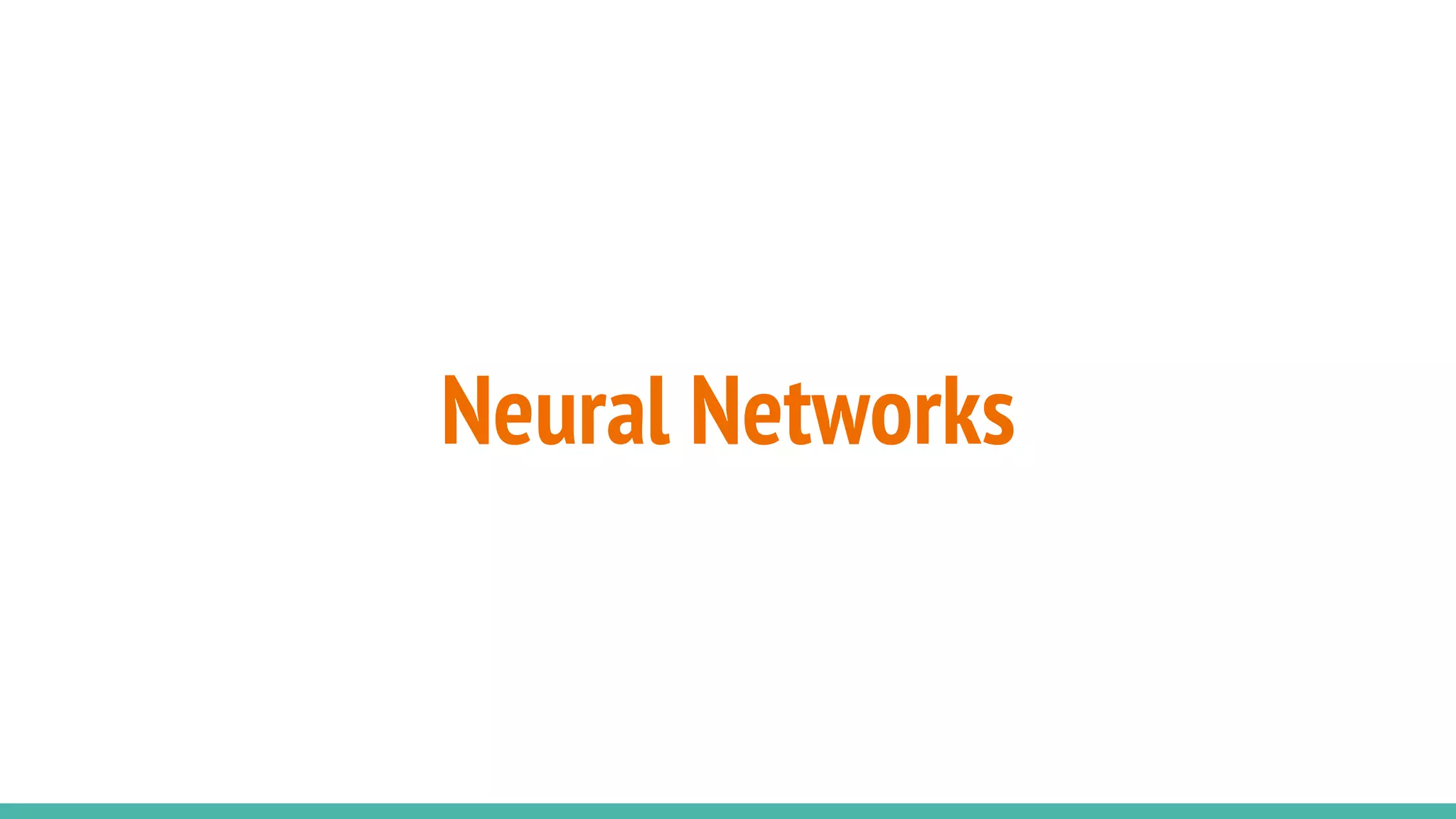
![Biological neuron
[Source: Stanford CS231n Course]](https://image.slidesharecdn.com/17-05-20-bertoni-deeplearningjumpstart-170723160304/75/Deep-Learning-Jump-Start-38-2048.jpg)
![Artificial neuron
[Source: Stanford CS231n Course]](https://image.slidesharecdn.com/17-05-20-bertoni-deeplearningjumpstart-170723160304/75/Deep-Learning-Jump-Start-39-2048.jpg)
![Common non linear activation functions
[Source: Machine Learning for artists]](https://image.slidesharecdn.com/17-05-20-bertoni-deeplearningjumpstart-170723160304/75/Deep-Learning-Jump-Start-40-2048.jpg)
![Examples of artificial neural network
[Source: Stanford CS231n Course]](https://image.slidesharecdn.com/17-05-20-bertoni-deeplearningjumpstart-170723160304/75/Deep-Learning-Jump-Start-41-2048.jpg)
![What is a supervised learning model
Model: y = f(x; W)
f is a way to use numerical parameters W (called weights), to map each input x
into a predicted output y.
Learning: the procedure that adjusting the parameters W aims to reduce the
discrepancy between y (model output) and t (target output) for each training
sample.
Example of error function (MSE):
[Source: Geoffrey Hinton Neural Networks Coursera Course]](https://image.slidesharecdn.com/17-05-20-bertoni-deeplearningjumpstart-170723160304/75/Deep-Learning-Jump-Start-42-2048.jpg)
![Training example with linear regression
Problem: we want to predict the price of a house knowing the area.
We have this data (our training dataset):
[Source: Visual and Interactive view of the basic of neural networks]](https://image.slidesharecdn.com/17-05-20-bertoni-deeplearningjumpstart-170723160304/75/Deep-Learning-Jump-Start-43-2048.jpg)
![Linear regression model
[Source: Visual and Interactive view of the basic of neural networks, Wikipedia]
Error (MSE):](https://image.slidesharecdn.com/17-05-20-bertoni-deeplearningjumpstart-170723160304/75/Deep-Learning-Jump-Start-44-2048.jpg)
![Linear regression model training - 1/2
[Source: Visual and Interactive view of the basic of neural networks]
Manual](https://image.slidesharecdn.com/17-05-20-bertoni-deeplearningjumpstart-170723160304/75/Deep-Learning-Jump-Start-45-2048.jpg)
![Descending the gradient of the error (simplified)
[Source: Quora question]](https://image.slidesharecdn.com/17-05-20-bertoni-deeplearningjumpstart-170723160304/75/Deep-Learning-Jump-Start-46-2048.jpg)
![Descending the gradient of the error (reality)
[Source]](https://image.slidesharecdn.com/17-05-20-bertoni-deeplearningjumpstart-170723160304/75/Deep-Learning-Jump-Start-47-2048.jpg)
![Linear regression model training - 2/2
[Source: Visual and Interactive view of the basic of neural networks]
Gradient Descent in action](https://image.slidesharecdn.com/17-05-20-bertoni-deeplearningjumpstart-170723160304/75/Deep-Learning-Jump-Start-48-2048.jpg)
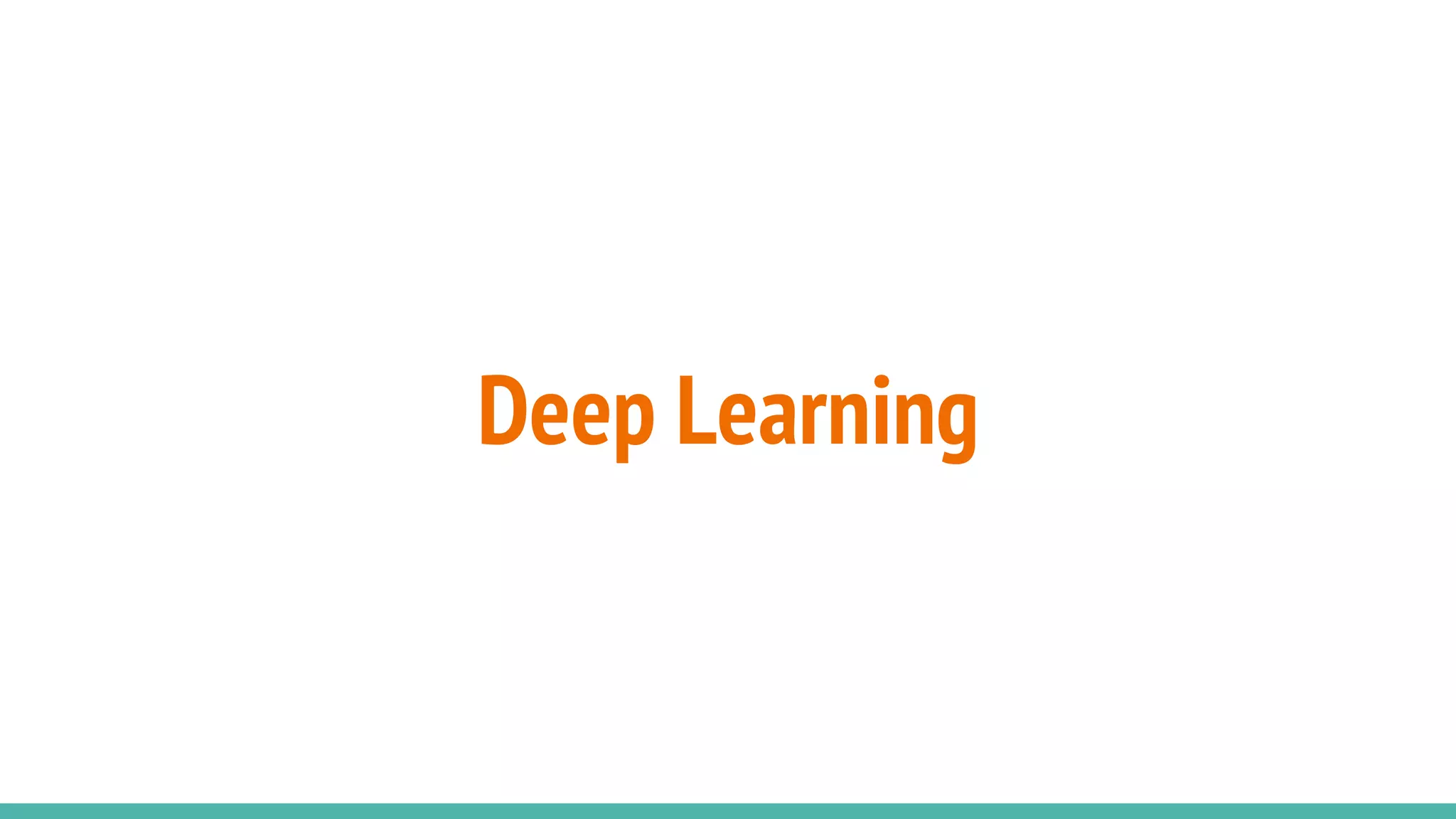
![Deep Learning definition
“A family of learning methods that use deep architectures to learn high-level
feature representations”.
Examples of deep learning:
● Convolutional neural networks (for images)
● LSTM networks (for sequences like text and music)
[Source: Neural Machine Translation by Jointly Learning to Align and Translate]](https://image.slidesharecdn.com/17-05-20-bertoni-deeplearningjumpstart-170723160304/75/Deep-Learning-Jump-Start-50-2048.jpg)
![Convolutional Neural Network layers
[Source: Stanford CS231n Course, in browser demo]](https://image.slidesharecdn.com/17-05-20-bertoni-deeplearningjumpstart-170723160304/75/Deep-Learning-Jump-Start-51-2048.jpg)
![Convolution - 1/2
● Doesn’t matter where the cat is
● Different position, same cat
● We can share the weights!
[Source: Udacity Deep Learning Course by Google]](https://image.slidesharecdn.com/17-05-20-bertoni-deeplearningjumpstart-170723160304/75/Deep-Learning-Jump-Start-52-2048.jpg)
![Convolution - 2/2
[Source: Stanford CS231n Course]
Graphical Demo](https://image.slidesharecdn.com/17-05-20-bertoni-deeplearningjumpstart-170723160304/75/Deep-Learning-Jump-Start-53-2048.jpg)
![Pooling
[Source: Stanford CS231n Course]](https://image.slidesharecdn.com/17-05-20-bertoni-deeplearningjumpstart-170723160304/75/Deep-Learning-Jump-Start-54-2048.jpg)
![CNN architecture: AlexNet (2012)
[Source: Visualize Neurons from Deep Models]](https://image.slidesharecdn.com/17-05-20-bertoni-deeplearningjumpstart-170723160304/75/Deep-Learning-Jump-Start-55-2048.jpg)
![Convolutional Neural Networks recap
[Source: Siraj Raval Youtube Channel]](https://image.slidesharecdn.com/17-05-20-bertoni-deeplearningjumpstart-170723160304/75/Deep-Learning-Jump-Start-56-2048.jpg)
